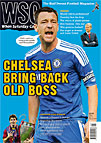 San Lorenzo fans are mobilising to ask questions of the dictatorship that turned their stadium into a supermarket, reports Joel Richards
San Lorenzo fans are mobilising to ask questions of the dictatorship that turned their stadium into a supermarket, reports Joel Richards
Barely three hours after the Mothers of the Disappeared finished their march, San Lorenzo fans filled the Plaza de Mayo in Buenos Aires. According to the organisers, there were 100,000 of them. Just like the Mothers, San Lorenzo were demanding justice for crimes committed during the 1976-83 dictatorship in Argentina.
The Mothers made their first public appearance in 1977, defying the brutal military regime that was kidnapping those considered “subversive” from the streets. By the end of the dictatorship an estimated 30,000 had “disappeared”. While the 1978 World Cup offered the opportunity to speak to foreign journalists and tell their dramatic story to the outside world, they made their first ever public appearance at a religious event held at San Lorenzo’s stadium, the Gasómetro, where they raised a banner in the crowd and demanded information.
The Mothers soon began to meet in front of the Casa Rosada, in Plaza de Mayo, every Thursday. The political panorama has changed dramatically in recent years but they continue to march to this day. The former generals no longer frequent cafes in expensive neighbourhoods; they now spend their time in the dock and behind bars. But as the scale of the dictatorship’s repression emerges, another aspect of the military rule is being debated, investigated, and challenged: the economic powers that supported the military and the profiteering that took place under the de facto government.
San Lorenzo mobilised their supporters in March and filled Plaza de Mayo with flares, flags, replica shirts and chants. They want to return to Boedo, the neighbourhood where the club was born. “Argentine democracy is in debt to San Lorenzo,” says Adolfo Res, a historian and a member of the San Lorenzo supporters’ group. “Everyone knows what the dictatorship did.”
In 1979 San Lorenzo were forced to sell the Gasómetro. Osvaldo Cacciatore, who was installed as the governor of Buenos Aires by the dictatorship, ordered that property owned by San Lorenzo, including the stadium, should be split up to open two important roads in the south of the city. There would be new housing built on the land and transport links would benefit as a result. When Cacciatore met with the San Lorenzo president, Moisés Annan, he dictated that the club would sell the stadium for £570,000. To ensure a smooth negotiation, Cacciatore placed his pistol on the desk and asked after Annan’s children. The threat was clear. Annan need only have looked to the Plaza de Mayo on Thursdays to see what Cacciatore was driving at.
The Gasómetro, so called because of the enormous gas containers nearby, opened in 1916 and reached its capacity of 75,000 by 1929, making it the national team’s home. It became known as the Wembley of Buenos Aires. It was not just a legendary stadium, famous for its wooden stalls, it was also a focal point for the community, with a strong accent on social work and activities for the local residents.
Not only did that vanish, but after San Lorenzo sold the Gasómetro, no houses were built and no roads were opened. In 1983, the zoning regulations were changed. The construction of supermarkets had not been permitted in the area, but Cacciatore enabled the sale of the land to the French company Carrefour. The land was sold for eight times the price he paid Annan, giving him a considerable personal profit on the deal. To this day the supermarket occupies the grounds on Avenida de la Plata in Boedo.
San Lorenzo were relegated in the year Carrefour bought the land, becoming the first of the five grandes to drop down a division. “Whether the board at the time were good directors is an entirely separate matter,” says Res, “but now we want to go back to Boedo.” With no ground, San Lorenzo moved from one stadium to the next, even playing home games at local rivals Huracán. Opposition fans still taunt them with “de que barrio sos San Lorenzo?” Since the 1990s, they have been in Bajo Flores, an area described by fans as “complicated”.
The supporters’ group lobbied the city government to pass the “historic reparation” law. After making headway, they are optimistic a decision could come by the end of the year. Along with the decree that would return the land to San Lorenzo, there will be a stadium, as well as a cultural and social centre, with space for private businesses. The complex will take the name of one of the club’s founders, the priest who first offered the group of workers kicking a ball about in the street a field to play on: Father Lorenzo Massa.
From WSC 303 May 2012